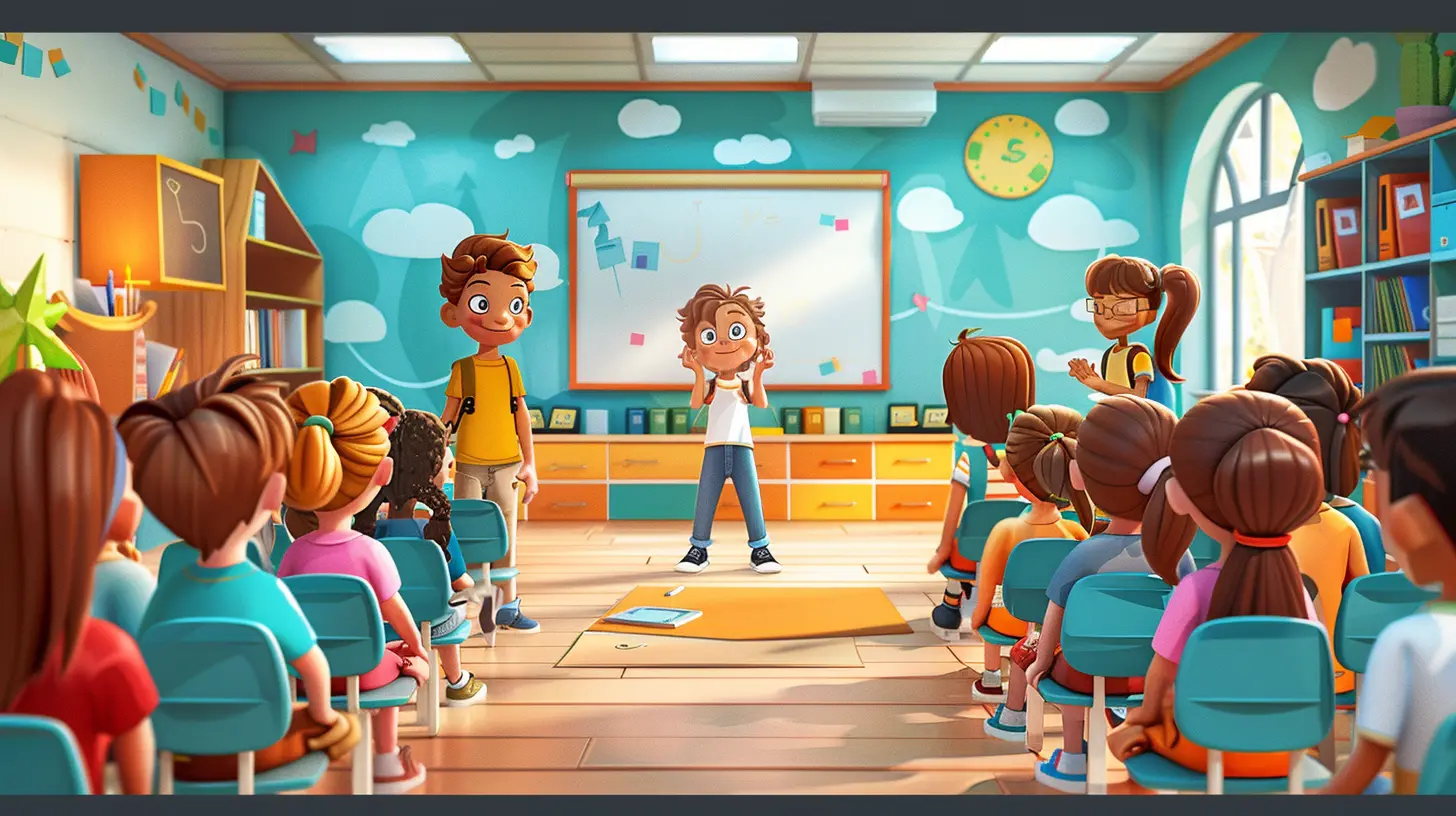Setting the Tone from Day One: Tips for a Successful Start
23 November 2024
Starting anything new can feel like stepping into uncharted territory. Whether it's the first day of school, a new job, or even launching a project, that initial experience often sets the stage for what’s to come. Ever heard the saying, "First impressions last"? Well, it’s true. The tone you set from day one can significantly influence the path ahead. But don't worry, I'm here to help you nail it down right from the start.
In this article, we’ll cover why setting the right tone is important and dive into practical tips to ensure you’re off to a successful start—whether you're a teacher, leader, or even a student. Let’s get going!

Why Setting the Tone is Crucial
Before we get into the nitty-gritty of "how," let’s talk about "why." Why is setting the tone so crucial from day one? Think of it like laying the foundation for a building. If the foundation is shaky, the entire structure is at risk. Similarly, the first day sets the foundation for what people can expect going forward.A strong start can build trust, clarity, and enthusiasm. It can also help to establish boundaries and expectations which, let’s face it, are essential to avoid unnecessary confusion or stress later on. Whether you’re a teacher meeting students for the first time or a manager onboarding new employees, day one is your golden opportunity to set the stage for success.
It’s All About First Impressions
First impressions are like wet cement: they harden fast, and they’re tough to reshape. People form opinions quickly—sometimes in just a matter of seconds. This applies to both personal and professional settings alike. Once that impression is formed, it can be difficult to change. So, the tone you set from day one can stick around for the long haul.Building Trust and Respect
Trust and respect are the cornerstones of any successful interaction. By setting a positive tone right from the beginning, you’re signaling to others that you’re someone they can rely on. Whether you’re teaching a classroom full of students or leading a team, people need to feel that you’re approachable, trustworthy, and respectful. This encourages open communication and a comfortable environment for everyone involved.
Practical Tips for Setting the Tone from Day One
Alright, let’s dig into the "how" now. Here are some actionable tips to ensure that you set the right tone from the get-go.1. Start with Clear Expectations
Imagine playing a game without knowing the rules. Frustrating, right? That’s exactly how people feel when they don’t know what’s expected of them. Be upfront about your expectations from day one.For example, if you’re a teacher, make sure your students know how the class will be structured. What are the rules for participation? How will grading work? What will assignments look like? If you’re a manager, be clear about job expectations, deadlines, and communication channels.
By setting clear expectations early on, you reduce the chances of confusion later. Plus, it shows that you’ve got your act together, which helps to build trust.
2. Model the Behavior You Want to See
Let’s face it: people are more likely to mimic what they see rather than follow what they’re told. If you want your students or team to be respectful, punctual, and diligent, you need to embody those qualities yourself. Think of yourself as a mirror—whatever energy or attitude you project will likely be reflected back at you.For example, if you want your class to be engaged and attentive, make sure you’re showing enthusiasm and passion for the subject. If you’re leading a team, demonstrate good time management and communication skills. Lead by example, and others will follow.
3. Open Lines of Communication
Communication is a two-way street. From day one, make sure people know they can come to you with questions, concerns, or suggestions. Create an environment where open dialogue is encouraged, and make yourself approachable.For teachers, this might look like setting aside time for students to ask questions or offering office hours. For leaders, it could mean regular one-on-one check-ins with team members or having an open-door policy.
In any case, the goal is to make sure people feel heard and understood. This fosters a sense of collaboration and trust, which will serve you well down the line.
4. Be Consistent
You know what’s frustrating? When someone says one thing but does another. Consistency is key when it comes to setting the tone. If you’re inconsistent, people will be left confused, and trust will erode.For example, if you tell your students that punctuality is important, but you show up late to class, guess what? They’re going to take your words less seriously. The same goes for the workplace. If you’re inconsistent with deadlines or expectations, your team won’t know what to prioritize.
Consistency creates a sense of stability, which is especially important in the early stages of any relationship, whether it's teacher-student or manager-employee.
5. Foster a Positive Environment
Nobody likes being in a toxic environment. One of the best ways to set a positive tone from day one is to foster an environment that encourages positivity, creativity, and mutual respect. This is especially important in educational or work settings, where people spend a lot of time together.For teachers, this could mean encouraging collaboration among students and celebrating successes in the classroom. For leaders, it might involve recognizing team contributions, encouraging innovation, or creating a supportive atmosphere where people aren’t afraid to take risks.
Positive environments lead to higher morale, better engagement, and ultimately, more success in whatever you’re trying to achieve.
6. Set Boundaries Early
Let’s be real for a second: boundaries are non-negotiable. If you don’t set boundaries from day one, people will push limits, sometimes unknowingly. By setting clear boundaries, you’re not only protecting yourself but also ensuring a balanced, respectful relationship.For example, teachers can set boundaries around class behavior, such as no phone use during lectures and respectful communication. Managers should establish boundaries regarding work hours, deadlines, and communication protocols.
Boundaries create a structure that helps everyone know their limits, making interactions smoother and more predictable.
7. Embrace Flexibility
While it’s essential to set expectations and boundaries, it’s also important to stay flexible. Life happens, and sometimes things don’t go according to plan. Being rigid can make you seem unapproachable and unwilling to adapt.For instance, let’s say a student missed a deadline because of a family emergency. Or maybe a team member is struggling with a project and needs more time. In these situations, showing a little flexibility and understanding can go a long way in building trust and rapport.
8. Create a Sense of Belonging
Everyone wants to feel like they belong. From day one, make an effort to create an inclusive environment where everyone feels like they’re part of the team or class. This can be as simple as learning names quickly, actively listening to what others have to say, and encouraging collaboration.For teachers, this might involve icebreaker activities or group projects that encourage peer interaction. For leaders, it could mean fostering teamwork, celebrating diversity, and making sure everyone’s voice is heard.
When people feel like they belong, they’re more likely to engage, contribute, and stick around.

The Role of Tone in Long-Term Success
Okay, so now that we’ve covered how to set the tone from day one, let’s talk about why this matters in the long run. The tone you set at the beginning doesn’t just affect the first day—it has a ripple effect that can shape the entire experience for everyone involved.Building Long-Term Relationships
The tone you set early on can pave the way for strong, long-lasting relationships. Whether it’s a teacher-student relationship or a manager-team dynamic, establishing trust, respect, and open communication right from the start can lead to a smoother, more productive relationship long-term.Reducing Misunderstandings
When expectations, boundaries, and communication channels are clear from the start, you significantly reduce the chances of misunderstandings down the line. This means fewer conflicts, less stress, and more focus on achieving goals.Increasing Engagement and Motivation
A positive tone can lead to higher levels of engagement and motivation. When people feel supported, respected, and understood, they’re more likely to give their best effort. Whether you’re teaching a class or leading a team, this can have a significant impact on overall success.
Conclusion
Setting the tone from day one is like planting seeds in a garden. With the right care and attention, those seeds will grow into something strong, beautiful, and fruitful. Whether you're a teacher, a manager, or even a student, the first day sets the tone for everything that follows. By being clear, consistent, and positive, you can set yourself—and others—up for long-term success.Remember, first impressions matter, but so does everything that comes after. By setting the right tone from the beginning, you're building a solid foundation for the future.
all images in this post were generated using AI tools
Category:
Classroom ManagementAuthor:

Bethany Hudson
Discussion
rate this article
16 comments
Wyatt McDermott
Setting the right tone from day one is crucial for success. Clear expectations, open communication, and consistent support foster a positive environment that empowers both students and educators to thrive. Embrace it!
March 25, 2025 at 11:57 AM

Bethany Hudson
Thank you for your insightful comment! I completely agree—establishing a positive environment from the start is essential for success.
Evelyn McClary
Setting the tone from day one isn't just about rules; it's about creating an atmosphere where curiosity thrives. A successful start hinges on fostering connections and inspiring engagement—because the best learning environments are built on enthusiasm, not just expectations.
February 3, 2025 at 11:27 AM

Bethany Hudson
Absolutely! Creating a curious and engaging atmosphere from the outset is key to building a vibrant learning environment. Connections and enthusiasm truly lay the groundwork for success. Thank you for sharing your insights!
Rex McElhinney
Kicking off with the right tone is like brewing the perfect cup of coffee: a dash of warmth, a sprinkle of enthusiasm, and just the right amount of cream!
January 30, 2025 at 11:53 AM

Bethany Hudson
Absolutely! Just like coffee, setting the right tone blends warmth and enthusiasm for a perfect start. Thanks for your insightful comment!
Seth McCall
With each dawn's light, cultivate a garden of joy; nurture minds and hearts, and watch curiosity bloom in every student.
January 27, 2025 at 11:42 AM

Bethany Hudson
Thank you for your beautiful words! Cultivating joy and curiosity is indeed essential for a thriving learning environment.
Isaac Mitchell
While "Setting the Tone from Day One" offers valuable insights, it's crucial to recognize that establishing a positive environment extends beyond initial impressions and requires ongoing engagement and adaptability throughout the year.
January 24, 2025 at 5:59 AM

Bethany Hudson
Absolutely! While first impressions are vital, fostering a positive environment is an ongoing process that thrives on continuous engagement and adaptability. Thank you for highlighting that!
Lydia Wyatt
Starting strong sets the foundation for success. Remember, every small effort builds a positive environment for both students and teachers.
January 16, 2025 at 3:24 AM

Bethany Hudson
Absolutely! Establishing a positive tone from the beginning truly creates an impactful learning atmosphere for everyone involved. Thank you for your insight!
Delia McGeehan
Initial tone shapes engagement; authenticity is key for lasting impact.
January 9, 2025 at 8:03 PM

Bethany Hudson
Thank you! I completely agree—authenticity truly fosters deeper connections and sets the stage for meaningful engagement from the very beginning.
Parker Butler
What a fantastic read! Setting the right tone from day one is crucial for a positive learning environment. Your tips are practical and motivational, making it easy for educators to create a welcoming atmosphere. I can’t wait to implement these strategies in my classroom. Thanks for sharing!
January 4, 2025 at 11:24 AM

Bethany Hudson
Thank you for your kind words! I'm glad you found the tips helpful and inspiring for your classroom. Best of luck with your implementation!
Viviana Snyder
Great insights! Setting a positive tone from the beginning truly makes a difference in the classroom. Your tips are practical and inspiring—perfect for educators looking to create an inviting and productive learning environment. Excited to implement these ideas! Keep up the fantastic work!
December 30, 2024 at 1:20 PM

Bethany Hudson
Thank you for your kind words! I'm thrilled that you found the tips helpful and inspiring. Best of luck implementing them in your classroom!
Zephyros Kirkpatrick
This article effectively highlights the importance of establishing a positive classroom environment from the beginning. The practical tips provided are straightforward and actionable, making it easy for educators to implement. Focusing on relationships and clear expectations can truly set the stage for a successful school year. Great insights for teachers!
December 17, 2024 at 3:27 AM

Bethany Hudson
Thank you for your thoughtful feedback! I'm glad you found the tips useful and that they resonate with the importance of building strong relationships in the classroom. Here's to a successful school year!
Pierce Snow
Setting the right tone from day one is crucial! It’s like making a perfect cup of coffee—strong, a little sweet, and with just the right amount of cream. Let’s avoid any bitter brews in the classroom!
December 12, 2024 at 9:33 PM

Bethany Hudson
Absolutely! The right tone sets the stage for a positive learning environment, just like that perfect cup of coffee. Let's brew success together!
Mariana Ross
What a fantastic read! Establishing a positive environment from the very first day sets the foundation for a successful year. These tips are invaluable for educators aiming to inspire and connect with their students. Thank you for sharing such insightful advice!
December 11, 2024 at 11:56 AM

Bethany Hudson
Thank you for your kind words! I'm glad you found the tips helpful for creating a positive classroom environment. Here's to a successful year ahead!
Hattie Barron
Loved this article! Setting a positive tone from the very first day is crucial for building a nurturing learning environment. Your tips are practical and easy to implement, making it accessible for all educators. Can’t wait to put these ideas into practice and foster an inspiring classroom atmosphere! Thank you!
November 30, 2024 at 1:15 PM

Bethany Hudson
Thank you so much for your kind words! I'm thrilled to hear you found the tips helpful and practical. Wishing you a fantastic start to your school year!
Peter Good
Setting the tone from day one is crucial for fostering a positive learning environment. Small gestures, clear expectations, and open communication can create a supportive atmosphere that encourages students to engage and thrive. Remember, the foundation you build in the beginning shapes their journey for the rest of the year.
November 28, 2024 at 4:28 AM

Bethany Hudson
Absolutely! Establishing a positive tone early on truly sets the stage for a productive and engaging learning experience. Your insights on gestures, expectations, and communication are spot on!
Halle Reese
Setting the tone from day one? It's like making coffee in the morning: a little preparation goes a long way! Just remember, if things get too serious, a spontaneous dance-off can lighten the mood. Let's face it, laughter is the best classroom accessory!
November 27, 2024 at 11:56 AM

Bethany Hudson
Absolutely! A positive tone is essential, and I love the idea of a dance-off—laughter truly does enhance the learning experience!
Heath McClary
Thank you for sharing these valuable tips! A positive start is crucial for fostering a supportive learning environment. Your insights will surely help educators make a meaningful impact from day one.
November 26, 2024 at 1:48 PM

Bethany Hudson
Thank you for your kind words! I'm glad you found the tips helpful for creating a positive learning environment.
MORE POSTS

Understanding the Link Between Discipline and Safety in Schools

The Role of Parental Involvement in Blended Learning

The Benefits of Mindfulness Practices for Students

Collaborative Learning for Problem-Solving in STEM Education

Understanding the Benefits of Liberal Arts Education

The Role of Parents as Advocates for Children with Learning Disabilities

Understanding the Emotional and Behavioral Challenges Linked to Learning Disabilities

Developing a Green Curriculum for Early Childhood Education

The Role of Gamification in Blended Learning

The Ultimate Guide to Expanding Your English Vocabulary